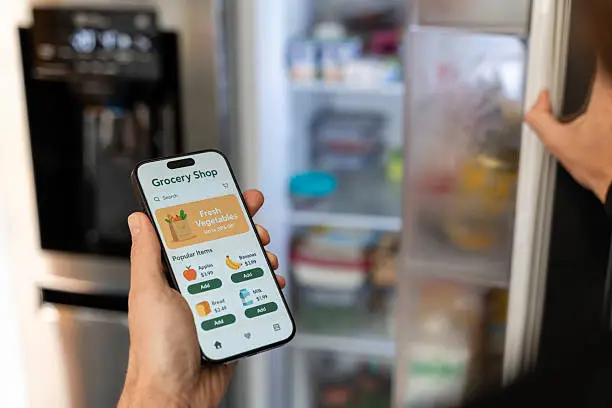


Grocery delivery apps revolutionize retail with faster shopping, home delivery, and wider reach, helping stores grow and customers save time.
The past decade has witnessed the retail sector undergo a significant shift, with the primary force driving this change being the introduction of grocery delivery apps. Shopping at the local supermarket is so old school; today, it can be accomplished with a few taps. The shift in consumer behavior has not only affected the way retailers interact and stock up, but it has also changed how they cope with consumers.
Pandemic-convenience to long-term customer loyalty, grocery store delivery apps are rewriting what retailing is all about in the new age. Let us get a closer look at how apps have turned the retailing world on its head – and what can be deduced from the disruption.
On-demand grocery shopping was a niche business before 2020. People typically preferred to select fruits, vegetables, and other perishables themselves. But then came the pandemic and changed everything. Lockdowns, sickness, and social distancing gave way to on-demand grocery apps becoming the new normal.
Today, this trend has continued. Saving time and convenience, coupled with personalized offers, have caused people to remain on these platforms. Statista estimates that the global online grocery market will be worth $1.1 trillion by 2029, indicating that this trend is here to stay.
One of the greatest reasons grocery apps exploded is due to convenience. Grocery shoppers do not need to plan grocery store trips, wait in line, or carry heavy bags anymore. It’s all at their fingertips — fresh produce and vegetables to frozen dinners, within hours. With features such as:
… online grocery shopping has never been simpler.
Platforms such as Instacart, Walmart+, Amazon Fresh, and Getir have perfected the convenience of saving time – something everyone loves. By making purchases simple, these sites have transformed shopping from a chore no more but an instant digital convenience.
The ripple effect of grocery delivery apps goes well beyond consumer convenience. They’ve revolutionized the way retailers do business.
With web stores, vendors have instant insight into what’s selling and when. All of this serves to reduce waste, optimize stock levels, and forecast demand much more accurately than previously.
Trend-to-buy behavior is easy to see with AI-driven analytics – i.e., which products peak on weekends or which products are seasonal top-sellers.
Unlike fixed shelf prices, grocery apps allow for real-time price adjustments by demand, stock, and promotion. Grocers can implement time-differentiated promotions or targeted offers to lure repeat shoppers and manage inventory at affordable costs.
Delivery apps require seamless coordination of warehouses, suppliers, and delivery personnel. This has pushed most retailers to revamp their supply chains – adding ERP systems, tracking delivery software, and automated fulfillment warehouses for faster order processing.
Most powerful of all is the application of data. All that search, tapping, and buying tells retailers so much about the behavior of their customers. It allows them to personalize recommendations, forecast demand, and optimize marketing campaigns — turning each interaction into a growth solution.
The revolution in grocery ordering apps has also taken the retail world to the next level. Small neighborhood shops, which were restricted to catering to locals in and around the neighborhood, are now able to reach thousands on aggregator platforms like Uber Eats or DoorDash.
The technological revolution has thus made democratization of access possible. It does not matter if one is ordering from a massive supermarket chain or the bakery downstairs; anyone can now play in the same virtual sandbox.
Also, most retailers have started offering:
All these would be impossible without the consumer data and infrastructure from delivery apps.
The prosperity of grocery delivery apps is dependent on intelligent technology. Several innovations have contributed to their popularity:
AI powers product recommendations, route optimization, and predictive analysis. For example, if a customer buys milk every Wednesday, the app will remind them or put it in their shopping cart automatically.
IoT devices like smart shelves and sensors track inventory in real-time to stock up on items that are out of stock, even before customers realize it.
Cloud computing makes it possible to have elastic, secure, and high-performance applications that can serve millions of users concurrently.
Various payment options – wallets to cards – give a smooth and secure payment experience, increasing conversion rates.
Customers are able to track their delivery courier, get the estimated time of arrival, and track updates – services that engender trust and transparency.
With each new company entering the digital retailing arena, these technologies are no longer an option – they’re a necessity.
The development of grocery apps has revolutionized consumers’ behavior towards shopping. Today’s consumers want:
Even older generations, who were reluctant about online shopping in the past, are now familiar with grocery apps.
Retailers that don’t shift risk losing share to faster, tech-forward competitors. This new reality emphasizes the need for digital transformation – not a fad, but a survival mechanism.
For companies, the popularity of grocery delivery apps has several lessons:
We at Rin Technologies help retailers develop strong, scalable, and simple-to-use apps that allow them to engage in this evolving game. Whether you’re launching your first grocery app or revamping one that already exists, our web development and mobile app development services are designed to guide your digital journey from idea to delivery.
